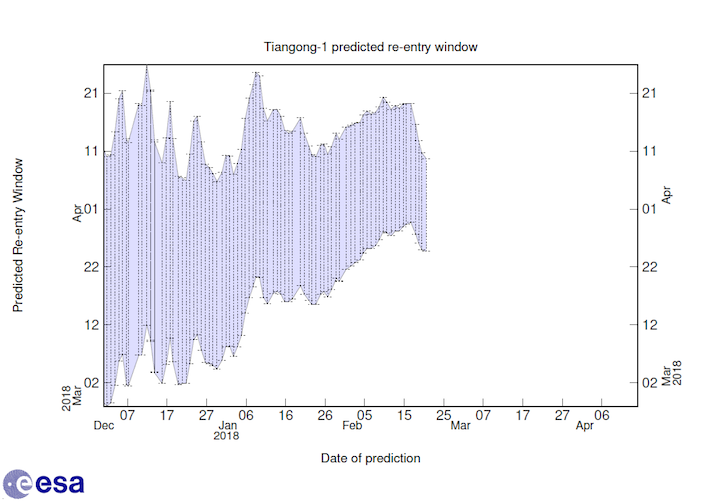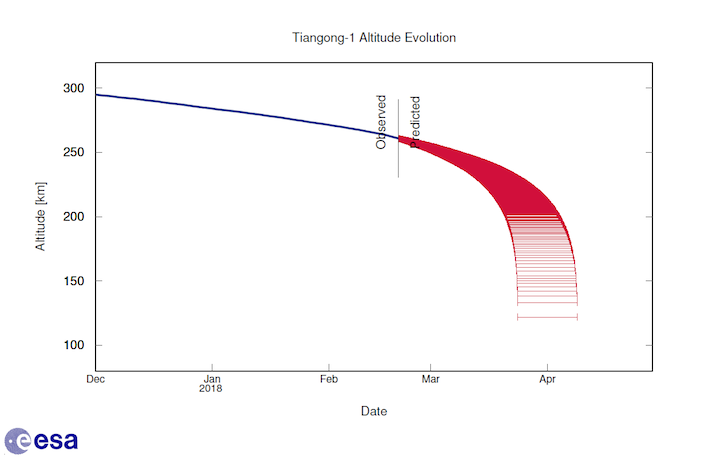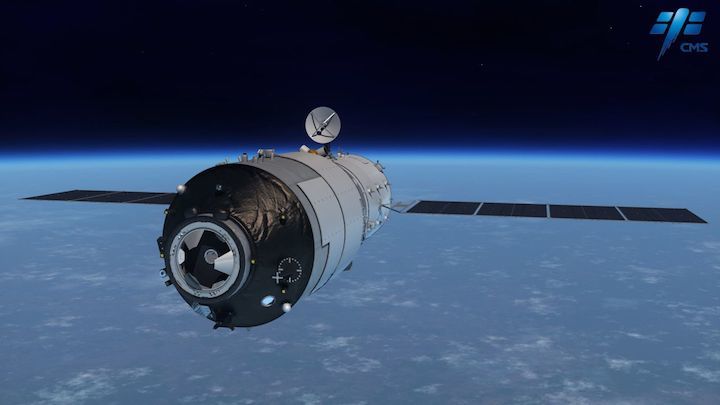A rendering of the Tiangong-1 space lab in orbit.
TIANGONG-1 REENTRY UPDATES
Latest reentry forecast provided by ESA’s Space Debris Office, ESOC, Darmstadt, Germany.
Update 6 March 2018
The current estimated window is ~29 March to ~9 April; this is highly variable.
Reentry will take place anywhere between 43ºN and 43ºS (e.g. Spain, France, Portugal, Greece, etc.). Areas outside of these latitudes can be excluded. At no time will a precise time/location prediction from ESA be possible. This forecast will be updated approximately every week in January and February.
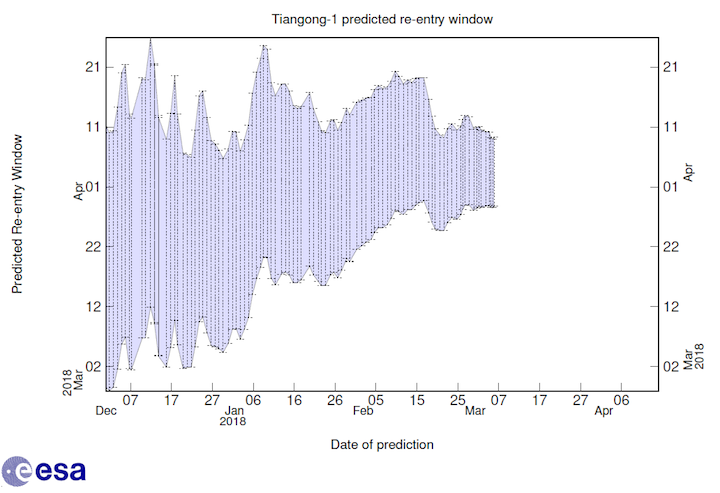
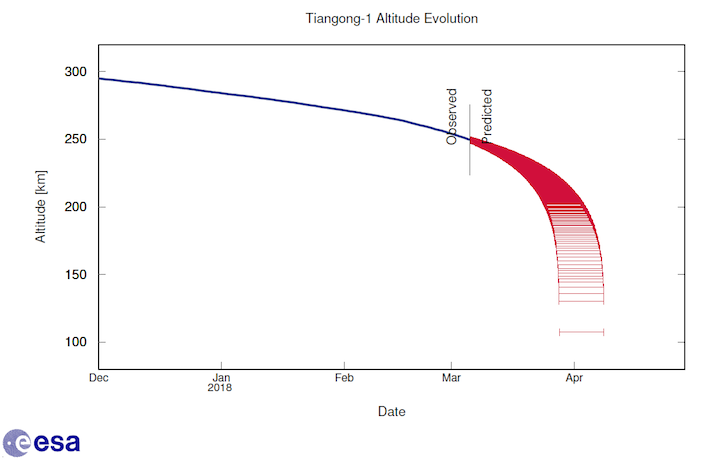
Quelle: ESA
---
Update: 17.03.2018
.
Tiangong-1: ESA reentry window estimate narrows to March 30-April 6

European Space Agency scientists tracking the orbit of China's Tiangong-1 space lab have released a new estimate for atmospheric reentry of between March 30 and April 6.
The estimate from ESA's Space Debris Office for March 15 states that the window is highly variable, due to the complexities of modelling the atmosphere, the dynamics of the reentering object and limitations in observing the spacecraft.
China's 8-metric-tonne Tiangong-1 space lab was launched in 2011 and used to test docking technology with the uncrewed Shenzhou-8 spacecraft shortly after.
It later tested life support systems by hosting two crews from the Shenzhou-9 and Shenzhou-10 missions in 2012 and 2013, acting as a stepping stone to an eventual large, modular Chinese Space Station.

The crewed Shenzhou-10 spacecraft docking with Tiangong-1 space lab in June 2013.
In 2016, it became apparent that the orbit of the spacecraft could not be changed and it would eventually make an uncontrolled atmospheric reentry.
ESA's Space Debris Office, based at the ESOC mission control centre in Darmstadt, Germany, has been tracking the orbit of Tiangong-1 and posting regular updates on its orbital status during 2018.
Current orbit
Tiangong-1 is currently orbiting with a perigee, or closest point to the Earth during orbit, of 224 km and apogee, or farthest point, of 246 km, according to USSTRATCOM's Joint Space Operations Center, which detects, tracks and identifies all artificial objects in Earth orbit and provides daily updates.
The space lab had a perigee of 235 km and apogee of 257 km on March 8. The decay of Tiangong-1's orbit, which is caused by atmospheric drag, is accelerating as the spacecraft runs into increasingly denser concentrations of particles at lower altitudes.

Tiangong-1 reentry window forecast by ESA's Space Debris Office as of 15 March, 2018.
The Aerospace Corporation, which is also following the situation, estimating that Tiangong-1 will reenter the Earth’s atmosphere around April 4th, 2018 plus or minus one week, in a March 15 update.
The last note issued by China to the United Nations Committee on the Peaceful Uses of Outer Space (COPUOS), in December, had a predicted window from the first 10 days of February to the last 10 days of March.

Chinese astronaut Wang Yaping during a live science lecture to school classrooms from orbit aboard Tiangong-1 in July 2013.
Tiangong-1 orbit and deorbiting
It was initially assumed that China would deorbit Tiangong-1 in a controlled manner, as with Tianzhou-1, using the same propulsion systems it used to regularly raise its orbit. However, in early 2016, China lost telemetry from the space lab, meaning the craft will come down randomly.
The orbit of Tiangong-1 carries it over the Earth between 43 degrees North to 43 degrees South, meaning as far south as southern Chile and Argentina, and a little farther north than New York and Chicago in the US and Rome in Italy.
Most of the craft will burn up on reentry, but anything that does not burn up could land at any point within this zone. Remaining debris is considered highly unlikely to pose a threat to people or infrastructure.
Despite the low probability of causing harm or damage, the fate of Tiangong-1 has attracted wide attention, with the Verge noting the role of humans having a bad grasp of probability and risk assessment.
Should the reentry occur over populated areas, it could put on a light show, as with a spent stage of a Long March 7 rocket over the United States in June 2016.
Any debris could, however, be contaminated with the remaining toxic and carcinogenic hypergolic fuel carried by the space lab as propellant.
The Chinese notification to the UN claims that the methylhydrazine and dinitrogen tetroxide propellant used by Tiangong-1 burned and destroyed along with its structural components during the course of re-entry.
For more, ESA has an FAQ on Tiangong-1 reentry which can be found here.
Long March 7 rocket stage burns up on reentry.
Towards a Chinese Space Station
While Tiangong-1 is doomed to suffer a fiery fate in the next few weeks, the later Tiangong-2, launched in 2016, is continuing its work in low Earth orbit after playing a role of a stepping stone towards a large, modular space station.
The first module of the Chinese Space Station (CSS), Tianhe, has already been constructed and will be launched around 2020.
Tianhe will be the CSS core module, and includes living quarters for astronauts. It will be joined by two science modules and orbit an altitude of around 390 kilometres above the Earth for around 10 years, carrying three astronauts for 3-6 months at a time.

A rendering of the completed Chinese Space Station, including docked Shenzhou and Tianzhou spacecraft.
A Chinese Space Lab Will Soon Fall From The Sky. Where It Lands, No One Knows

A model of the Tiangong-1 space station at a Chinese airshow in 2010. The real Tiangong-1 will reenter the atmosphere around the end of March.
-
A Chinese space lab the size of a city bus will soon be falling back to Earth, and no one knows exactly where bits of it might crash down.
Current predictions say that the 19,000-pound lab should re-enter the earth's atmosphere sometime in the last few days of March or the first few days of April.
The lab is called Tiangong-1, which means "heavenly palace." China launched it into space in 2011. The outpost was briefly visited twice by Chinese taikonauts, including Wang Yaping, who beamed down a science lecture to schoolchildren.
Although Tiangong-1 has been called a Chinese "space station," it actually is just a precursor to China's planned space station, says Joan Johnson-Freese, a professor at the Naval War College.
Since 1992, she says, China has been following a methodical program "to demonstrate human space flight and culminate with a large space station."
For that, China's space agency needs to get experience with things like docking and long-term life support in space. Tiangong-1 and another lab in orbit called Tiangong-2, "have been technology test bed laboratories to do experimentation on all those different areas and more," she explains.
Now, though, Tiangong-1 is headed back down. And even though space junk this size falls to Earth a few times a year, it's usually something like a spent rocket stage — not a home-away-from-home for space travelers.
"These kinds of events are noteworthy and people in this business kind of watch to see what they can learn about how these things come apart as they come down," says Bill Ailor of the Aerospace Corporation's Center for Orbital and Reentry Debris Studies.
Most of it, though not all, should burn up during the fiery re-entry.
"Somewhere between, say, 2,000 and 8,000 pounds might come down," Ailor says.
The possible impact zone covers about two-thirds of the globe, including a lot of the continental United States. But exactly where and when is hard to predict because the vehicle will interact with the atmosphere, which is constantly changing.
Still, don't worry about getting hit, says Ailor. "It's just not a very likely event that a particular person would have a problem with it," he says.
In 60 years of space exploration, only one person — an American woman named Lottie Williams — is known to have been struck by falling space junk, says Ailor, "and it was just like a piece of fabric material that kind of brushed her on the shoulder."
He hopes that someone gets to see the bright streaks created by Tiangong-1 breaking up and burning.
"It would be a beautiful thing to watch," says Ailor.
But since most of our planet is covered by oceans, he says the most likely scenario is that it will come down over the water and never be seen or heard from again.
Quelle: npr
---
Update: 24.03.2018
.
China's Space Station Will Fall to Earth, But When and Where? Here's the Latest

The impending re-entry of China's Tiangong-1 space station is being closely monitored by The Aerospace Corporation's Center for Orbital and Debris Reentry Studies (CORDS), but experts still can't say exactly when and where the bus-size laboratory will fall to Earth.
Currently, the space station is predicted to re-enter Earth's atmosphere around April 1, plus or minus 4 days.
However, due to the uncertainties involved, it is very difficult to predict the exact timing of any space object re-entry, according to the Aerospace Corporation.
According to CORDS, sources of uncertainty include:
- significant variation in the density of the upper layers of the atmosphere
- orientation of the spacecraft over time
- physical properties of the spacecraft, including the exact mass and material composition
- exact location and speed of the space station
"When aggregated, these factors translate into a re-entry timing uncertainty that is roughly 20 percent of the 'time to go'—the time remaining between the date of the prediction and the predicted date of re-entry,"
Surviving debris
Tiangong-1 will reenter somewhere between the latitudes of 43 degrees north and south, and any surviving reentry debris will most likely fall into an ocean.
"The odds of space debris hitting you are less than one in 1 trillion. Surviving debris from Tiangong-1 might be carrying or be comprised of toxic materials. CORDS experts advise that it is best to not touch any space debris or breathe in any vapors it may release," according to the orbital debris and reentry study group.
What can a ground observer see?
Incandescent objects during this re-entry may be visible and will likely last up to a minute or more, depending on time of day, visibility conditions, and the observer's location, according to Aerospace's CORDS update.
China's Tiangong-1 space lab launched into orbit without a crew in September 2011. It hosted three visiting spacecraft - the uncrewed Shenzhou 8 spacecraft, which made the first docking with Tiangong-1 in November 2011, and the crewed Shenzhou-9 in 2012 and Shenzhou-10 in 2013.
After the Shenzhou-10 mission, Chinese flight controllers placed Tiangong-1 in sleep mode and in March 2016, the space lab stopped sending data back to Earth, sealing its fate.
China does have a second small space station in orbit today, Tiangong-2, which launched in September 2016 and hosted a visiting crew during the Shenzhou-11 mission later that year.
Quelle: SC
---
Update: 29.03.2018
.
CHINA’S TIANGONG-1 REENTRY EXPECTED IN NEXT FEW DAYS
China’s small Tiangong-1 space station is expected to make an uncontrolled reentry at the end of this week or the beginning of next. Space objects routinely reenter through the atmosphere and most are destroyed in the fiery process, but there is a small chance that some parts of Tiangong-1 will reach the surface. Predicting when and where is difficult.
China’s official Xinhua news service said yesterday that reentry is anticipated between March 31 and April 4. It expects the space station to be “fully burnt” during the process.
Among the many Western organizations and satellite tracking amateurs closely following the decay of Tiangong-1’s orbit are the U.S. Aerospace Corporation and the European Space Operations Center (ESOC), part of the European Space Agency. The Aerospace Corporation is a federally funded research and development center (FFRDC) that supports the Air Force, including its space tracking operations.
Aerospace and ESOC both issued their most recent predictions yesterday and they largely agree with each other and with China’s offcial estimate. Aerospace predicts reentry on April 1 ± two days, and ESOC predicts March 30-April 2.
If any portion of the 8.5 metric ton (MT) space station survives all the way down to Earth, chances are it will do so over water, which covers 70 percent of the Earth’s surface. Apart from that, it can come down anywhere along its flight path from 42.65 degrees north latitude to 42.65 degrees south latitude.
It is expected to make an uncontrolled reentry, which can be affected by a number of atmospheric factors. Thus the predictions are variable.
The chances that anyone might be hit by a piece of debris are extremely small. The Aerospace Corporation calculates it this way: “the probability that a specific person (i.e. you) will be struck by Tiangong-1 debris is about one million times smaller than the odds of winning the Powerball jackpot.” Its website also had a handy map showing the portions of the globe where debris conceivably might fall. [https://tinyurl.com/y6w75hmu].
Tiangong-1 is China’s first space station. Launched in 2011, it hosted two three-person crews in 2012 (Shenzhou 9) and 2013 (Shenzhou 10). A second space station, Tiangong-2, is currently in orbit and was visited by one crew (Shenzhou 11) in 2016. Additional visits are not expected. China now is focusing on development and launch of a three-module 60 MT space station that would be completed in the early 2020s.
Quelle: Space and Technology Policy Group


